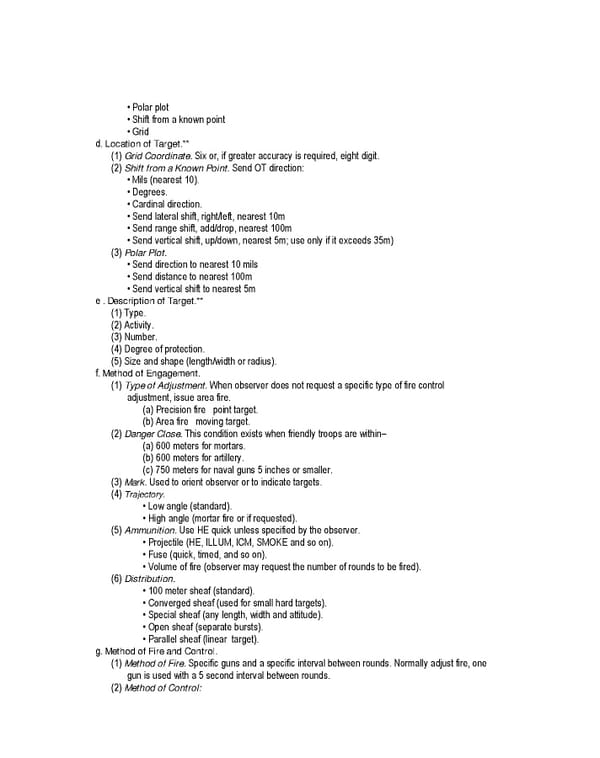• Polar plot • Shift from a known point • Grid d. Location of Target.** (1) Grid Coordinate. Six or, if greater accuracy is required, eight digit. (2) Shift from a Known Point. Send OT direction: • Mils (nearest 10). • Degrees. • Cardinal direction. • Send lateral shift, right/left, nearest 10m • Send range shift, add/drop, nearest 100m • Send vertical shift, up/down, nearest 5m; use only if it exceeds 35m) (3) Polar Plot. • Send direction to nearest 10 mils • Send distance to nearest 100m • Send vertical shift to nearest 5m e . Description of Target.** (1) Type. (2) Activity. (3) Number. (4) Degree of protection. (5) Size and shape (length/width or radius). f. Method of Engagement. (1) Type of Adjustment. When observer does not request a specific type of fire control adjustment, issue area fire. (a) Precision fire point target. (b) Area fire moving target. (2) Danger Close. This condition exists when friendly troops are within– (a) 600 meters for mortars. (b) 600 meters for artillery. (c) 750 meters for naval guns 5 inches or smaller. (3) Mark. Used to orient observer or to indicate targets. (4) Trajectory. • Low angle (standard). • High angle (mortar fire or if requested). (5) Ammunition. Use HE quick unless specified by the observer. • Projectile (HE, ILLUM, ICM, SMOKE and so on). • Fuse (quick, timed, and so on). • Volume of fire (observer may request the number of rounds to be fired). (6) Distribution. • 100 meter sheaf (standard). • Converged sheaf (used for small hard targets). • Special sheaf (any length, width and attitude). • Open sheaf (separate bursts). • Parallel sheaf (linear target). g. Method of Fire and Control. (1) Method of Fire. Specific guns and a specific interval between rounds. Normally adjust fire, one gun is used with a 5 second interval between rounds. (2) Method of Control:
 Ranger Handbook Page 59 Page 61
Ranger Handbook Page 59 Page 61